Finding your way through the crowded world of financial news and research can feel overwhelming. Each source offers a mix of expert picks, breaking news, or deep analysis. Some focus on helping beginners build confidence while others dig into advanced strategies for professionals. Would you rather get daily updates or in-depth reports every month. Do you want short news or long-form guides. With so many choices out there, discovering which service fits your needs best can make a real difference in how you invest and plan for your future.
Table of Contents
Finblog
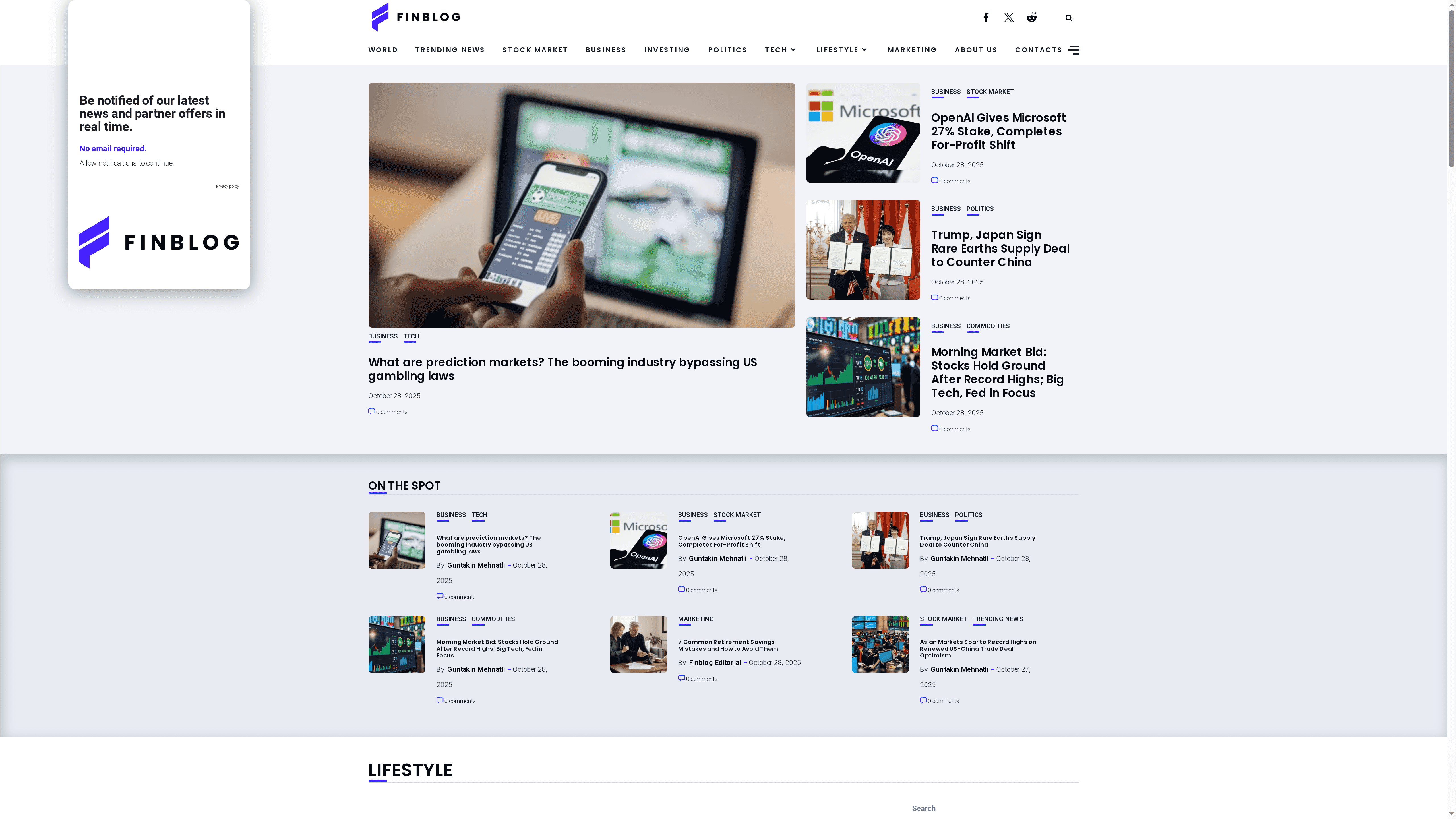

At a Glance
Finblog is a focused financial news and analysis site that combines timely market coverage with education-focused content to help readers make better investment decisions. The site pairs trending market news, expert commentary, and retirement planning guidance with a user-first design that prioritizes lead capture for advisory services. Bottom line: Finblog is an authoritative, conversion-optimized hub for investors and professionals who want concise news and actionable context without the clutter.
Core Features
Finblog delivers a steady stream of the latest trending financial news and analysis, in-depth articles on stocks, cryptocurrencies, and investing, plus coverage of political and economic events that influence markets. It also offers retirement planning and savings advice alongside market summaries and real-time updates. The visible CSS and form-focused layout signal a platform built to route interested readers into newsletters, consultations, or subscriptions through clearly designed, responsive form elements.
Pros
- Comprehensive editorial coverage: The site offers wide-ranging articles across market news, investing, politics, technology, and retirement planning, giving readers multiple angles on financial topics.
- Timely updates and market summaries: Frequent, up-to-date reporting helps you stay current with market moves and breaking developments.
- Expert insights and analysis: Analysis-driven pieces provide context that moves beyond headlines to explain why markets react the way they do.
- User-focused design for navigation: A clean, professional layout and clear information hierarchy make it easy to scan headlines and drill into topics.
- Lead-capture and conversion-focused UX: Custom-styled forms, checkboxes, and embedded CAPTCHA demonstrate an emphasis on secure, high-converting user interactions for newsletter signups and advisory outreach.
Who It’s For
Finblog is ideal for retail investors, finance professionals, and serious individual investors who want a reliable feed of market news plus actionable analysis and retirement guidance. It also suits working professionals and students building financial literacy who appreciate a site that both informs and funnels interested readers toward deeper, advisory-level engagement.
Unique Value Proposition
Finblog’s strength is the marriage of high-quality financial journalism with a deliberate, conversion-optimized experience. Unlike generic news aggregators, Finblog is engineered to educate readers while capturing interest in a professional advisory funnel—via custom forms, responsive controls, and embedded CAPTCHA for security—so its audience can move from reading to subscribing or booking consultations seamlessly. This design choice positions Finblog not just as an information source but as a practical bridge to financial services and education. The site’s concentrated editorial scope (markets, crypto, politics, retirement) paired with UX designed for trust and conversion gives it an edge over content-only competitors: it’s built to convert curiosity into engagement and ultimately into qualified leads for financial advice.
Real World Use Case
A retail investor tracks Finblog’s market summaries each morning, reads an in-depth piece on geopolitical risk, and uses the site’s signup form to receive a targeted newsletter that aligns with their retirement goals—turning daily reading into a curated advisory relationship.
Pricing
Not specified, likely free access to news articles with lead-generation paths for paid consultations or subscription services.
Website: https://finblog.com
The Motley Fool
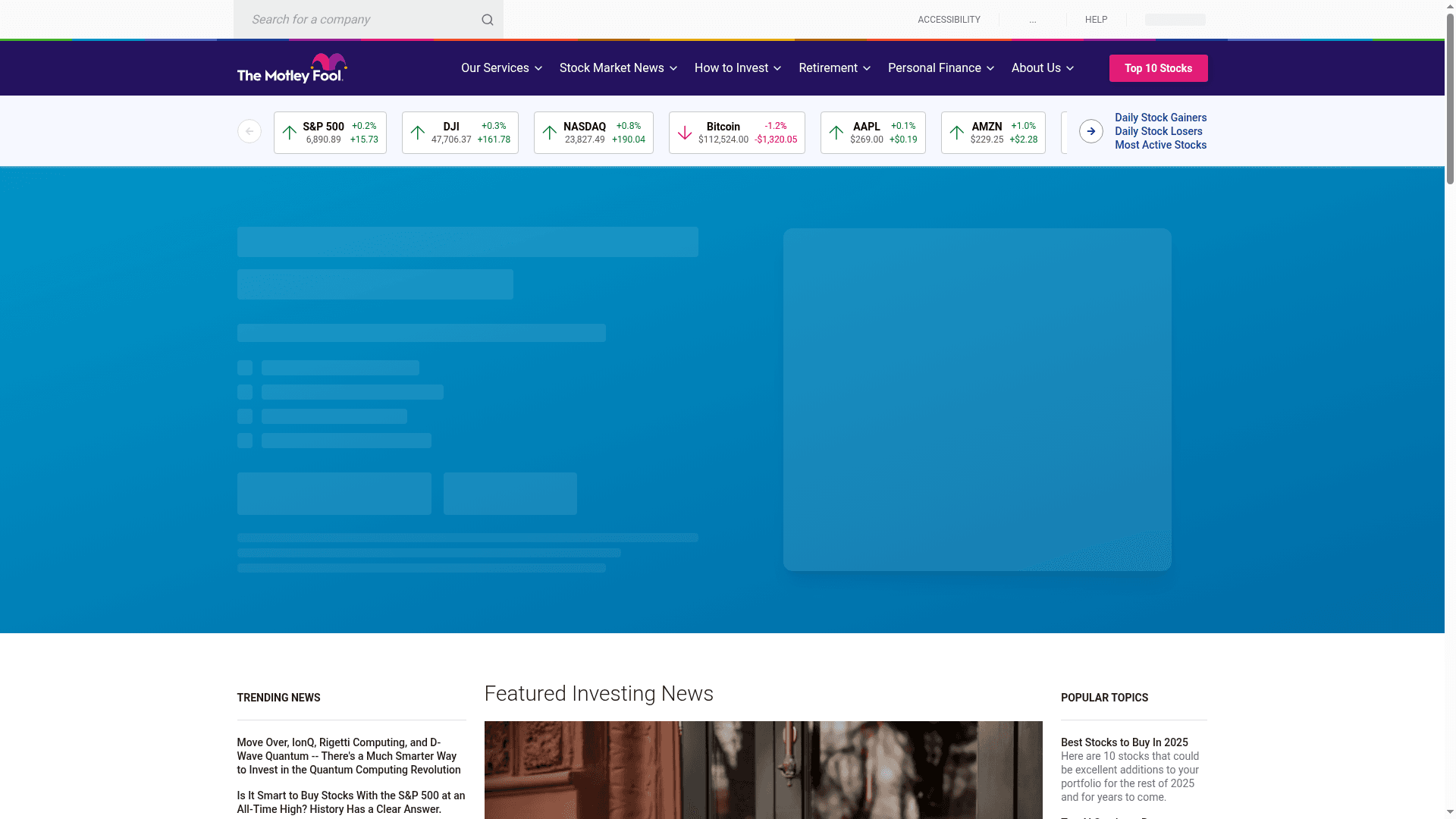

At a Glance
The Motley Fool is a long-established investment research service founded in 1993 that focuses on stock recommendations, educational content, and portfolio strategies. Its core offering delivers monthly stock picks—typically 2 for Stock Advisor and 5 for Rule Breakers—backed by proprietary analytics and long-term guidance. The service emphasizes buy-and-hold philosophy and offers tailored strategies for cautious, moderate, and aggressive investors. Bottom line: it’s best for individual investors seeking structured, long-term stock guidance rather than traders looking for short-term signals.
Core Features
The Motley Fool combines monthly stock picks, stock rankings and analysis, and portfolio strategy frameworks designed for different risk profiles: cautious, moderate, and aggressive. It provides proprietary analytics tools to help you evaluate market and stock insights alongside an extensive library of educational articles covering financial planning and investing basics. Subscription levels (Stock Advisor, Rule Breakers, plus) offer varying frequency and depth of picks and additional features, making it relatively straightforward to match a plan to your goals.
Pros
- Proven longevity and track record: The service is trusted with over 20 years of market-beating track record, which lends credibility to its investment approach.
- Tailored strategies for different risk profiles: Motley Fool explicitly presents cautious, moderate, and aggressive portfolio strategies so you can align recommendations with your tolerance for risk.
- Rich educational resources and tools: The platform offers a wide range of articles and proprietary analytics that help investors learn and analyze stocks more effectively.
- Focus on long-term wealth accumulation: The emphasis on buy-and-hold investing supports disciplined, long-term portfolio building rather than chasing short-term market moves.
- Multiple subscription levels: Offering Stock Advisor, Rule Breakers, and other tiers gives users flexibility to choose frequency and intensity of recommendations.
Cons
- Subscription costs can be high for some users: Annual prices such as Stock Advisor around $199 may feel expensive relative to free resources or lower-cost alternatives.
- Heavy emphasis on stock recommendations: If you prefer a broader multi-asset advisory (bonds, alternatives, or tax planning), Motley Fool’s stock-centric focus may not meet your needs.
- Volume of content can overwhelm beginners: The breadth of articles, tools, and picks can be difficult to parse for investors who want a simpler, more curated experience.
Who It’s For
The Motley Fool suits individual investors interested in long-term growth, stock market enthusiasts, and those who want structured guidance and educational resources. If you’re building a diversified equity portfolio and favor a patient, research-driven approach, this service gives a clear framework and actionable monthly ideas.
Unique Value Proposition
Motley Fool pairs decades of published recommendations with proprietary analytics and an education-first mindset, creating a one-stop hub for investors who want monthly stock ideas plus the tools to study and hold them for the long term.
Real World Use Case
An individual investor subscribes to Stock Advisor to receive the monthly two-stock picks, uses the platform’s analytics to evaluate fit within a diversified portfolio, and follows Motley Fool’s long-term strategy to gradually build wealth over several years.
Pricing
Starting at around $199 annually for Stock Advisor, with Rule Breakers priced similarly or higher depending on features and promotions.
Website: https://fool.com
Investors Alley
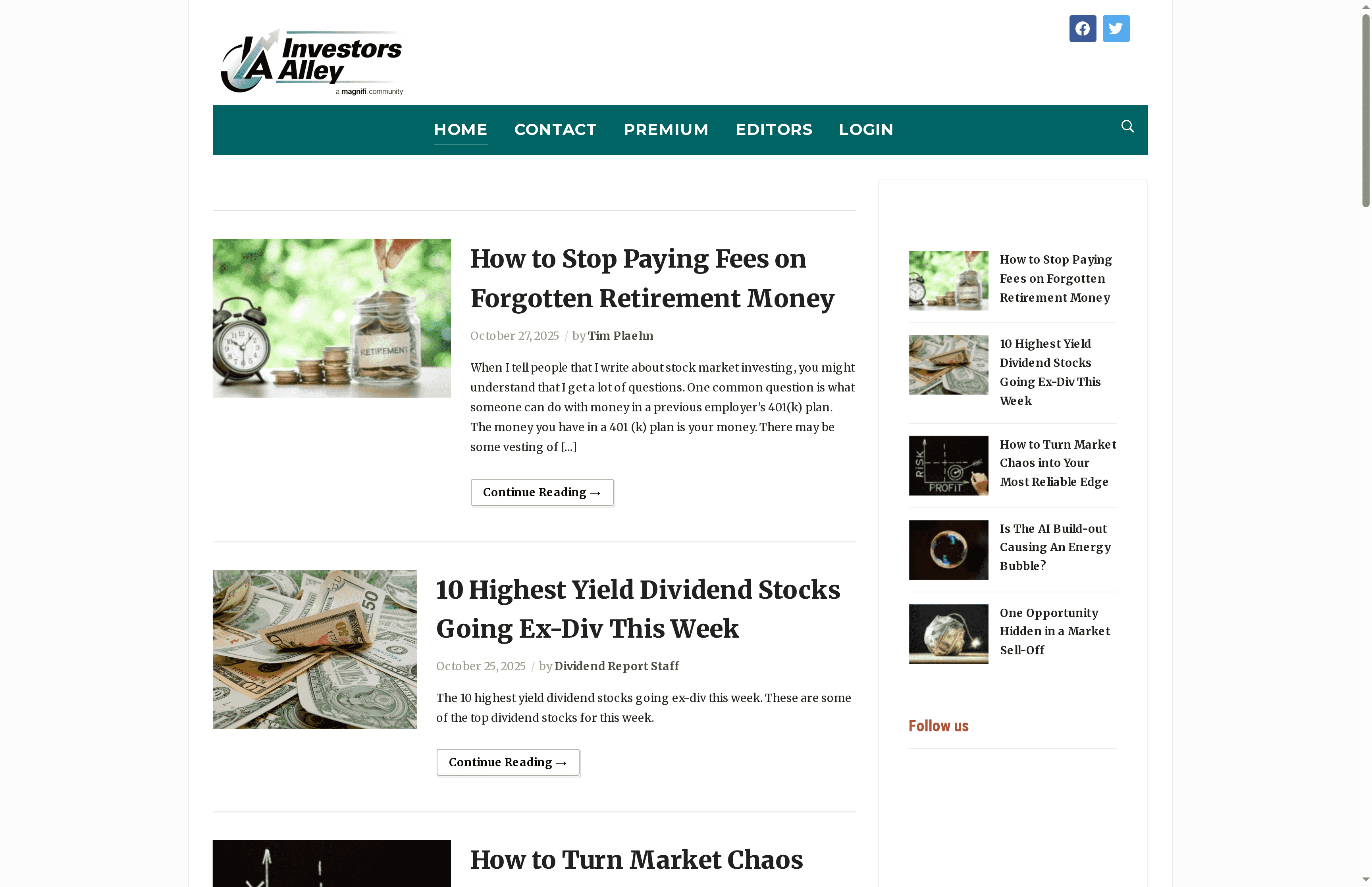

At a Glance
Investors Alley is an education-first platform that delivers market analysis, dividend-focused research, and commentary on energy investments. It’s run by Magnifi Communities LLC and carries the credibility of an SEC-registered investment adviser, which matters when you’re comparing sources. The content is geared toward helping investors learn risk management and spot ideas, though it stops short of highly personalized advisory recommendations. If you want timely analysis and teachable market context, this is a dependable starting point.
Core Features
Investors Alley provides market analysis articles, educational guides on investing and trading strategies, focused coverage of dividend stocks and energy sectors, and research from experienced market analysts. The platform emphasizes risk disclosure and investor education rather than transactional tooling, so you get narrative-driven insights and strategy explanations rather than brokerage-style execution or interactive trading tools.
Pros
- Comprehensive educational content: The site offers broad instructional material that helps both beginners and experienced investors sharpen fundamentals and strategy understanding.
- Wide topical coverage: You’ll find analysis across stocks, dividend strategies, and the energy sector, which supports diversified research approaches.
- Operated by a registered adviser: Being run by Magnifi Communities LLC and tied to an SEC-registered adviser adds a layer of credibility and formal compliance to its content.
- Timely market analysis and ideas: The platform publishes market commentary and investment ideas that are clearly aimed at helping readers identify potential opportunities.
- Emphasis on risk management: Articles frequently include risk disclosure and guidance on investing safely, which helps ground speculative ideas in practical caution.
Cons
- Primarily educational, not personalized: The content is focused on education and may not provide specific, personalized investment recommendations tailored to your portfolio.
- Few interactive tools: There is limited availability of interactive analysis tools or platform features for trade execution and portfolio management.
- Potential for affiliated bias: Some opinions may show bias toward promoted investments due to affiliated interests, which requires you to read critically.
Who It’s For
Investors Alley is best for individuals who want to learn and self-direct their investing: retail investors, financial hobbyists, and working professionals who value clear market commentary and educational resources. It fits those seeking research-driven ideas on dividend income and energy exposure, rather than investors who need hands-on brokerage services or personalized wealth management.
Unique Value Proposition
Investors Alley stands out by combining accessible, education-focused content with analyst-driven market commentary and a formal adviser-backed structure. That blend makes it useful for readers who want to learn the “why” behind investment ideas while relying on published risk disclosures.
Real World Use Case
A retail investor uses Investors Alley to study dividend stock fundamentals and the energy sector’s trends, then applies those lessons to screen stocks for portfolio diversification while explicitly considering the platform’s risk guidance.
Pricing
Information about specific pricing is not provided on the website; some content appears to be free while other material may be available through subscription or paid services.
Website: https://investorsalley.com
Seeking Alpha
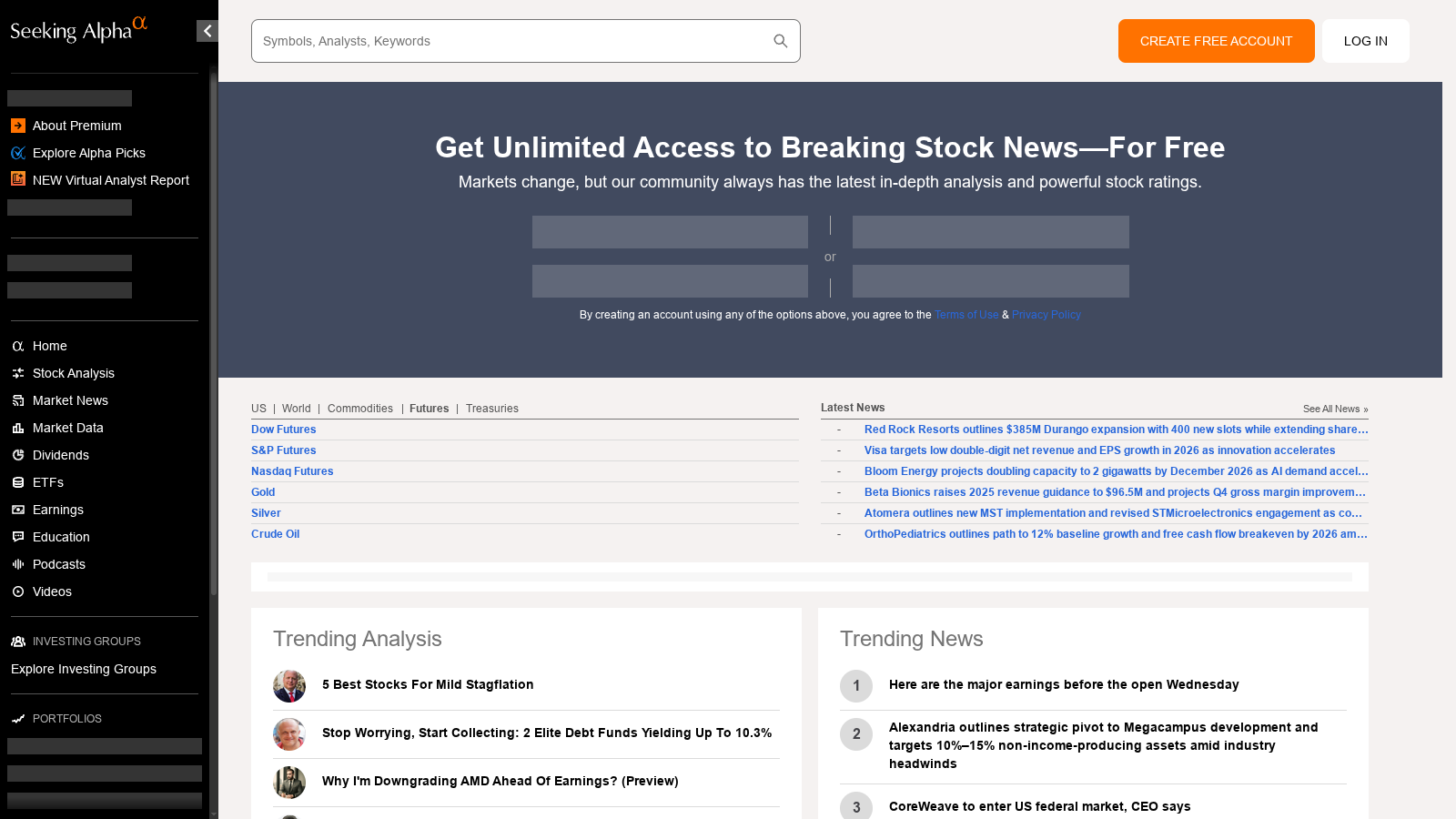

At a Glance
Seeking Alpha is an industry-leading financial research platform that combines in-depth analysis, real-time market news, and contributions from thousands of professional and individual analysts. It covers all major asset classes and supplies tools for screening and quant ratings so you can move from idea to action more quickly. Bottom line: it’s a strong research hub for self-directed investors, but content quality varies and some features require account access.
Core Features
Seeking Alpha’s core strengths are its breadth of coverage and the mix of quantitative and community-driven content. The platform offers stock market analysis and tools, real-time news and analysis, contributor articles from a large investing community, quant ratings, stock-screening capabilities, and market data across stocks, commodities, futures, and indexes. Together these components create a workflow where you can discover ideas, test them with screening tools, and monitor market moves in real time.
Pros
- Wide coverage of asset classes: Seeking Alpha provides data and commentary across stocks, commodities, futures, and indexes, giving you a multi-asset view in one place.
- Community-driven insights: Thousands of contributors mean you see diverse perspectives and niche ideas that institutional feeds might miss.
- Access to analyst articles and ratings: You can read detailed analyst write-ups and consult quant ratings to cross-check qualitative views with data-driven signals.
- Timely market news and updates: Real-time news feeds help you react to market-moving developments as they happen.
- Tools for stock screening and analysis: Built-in screening and market-data tools let you filter opportunities and run basic quantitative assessments quickly.
Cons
- Some features require account creation and login: You may need to register before you can access certain articles, tools, or full datasets, which adds friction for a first look.
- Potential for biased or opinion-based articles: Contributor content includes subjective views, so articles can reflect individual bias rather than consensus analysis.
- Dependent on user-generated content quality: Because much content is community-sourced, the signal-to-noise ratio varies and you must vet contributors carefully.
Who It’s For
Seeking Alpha is tailored to individual investors and analysts who want comprehensive financial analysis, frequent market commentary, and a community to debate ideas. If you do your own research, like to read long-form analyst reports, and want tools to screen and quantify ideas, this platform will fit into your workflow.
Unique Value Proposition
Seeking Alpha’s unique value lies in combining wide market coverage with a large, active contributor base and quant-driven tools. That blend gives you both human insight and numerical scoring, making it easier to find differentiated ideas and then test them with the platform’s screening and market-data features.
Real World Use Case
An individual investor researching a potential stock purchase can read multiple analyst articles on Seeking Alpha, check the quant rating, run a quick screen to compare peers, and monitor real-time news that could affect the thesis—all from one place.
Pricing
Free tier available; premium subscription details are not specified.
Website: https://seekingalpha.com
Zacks
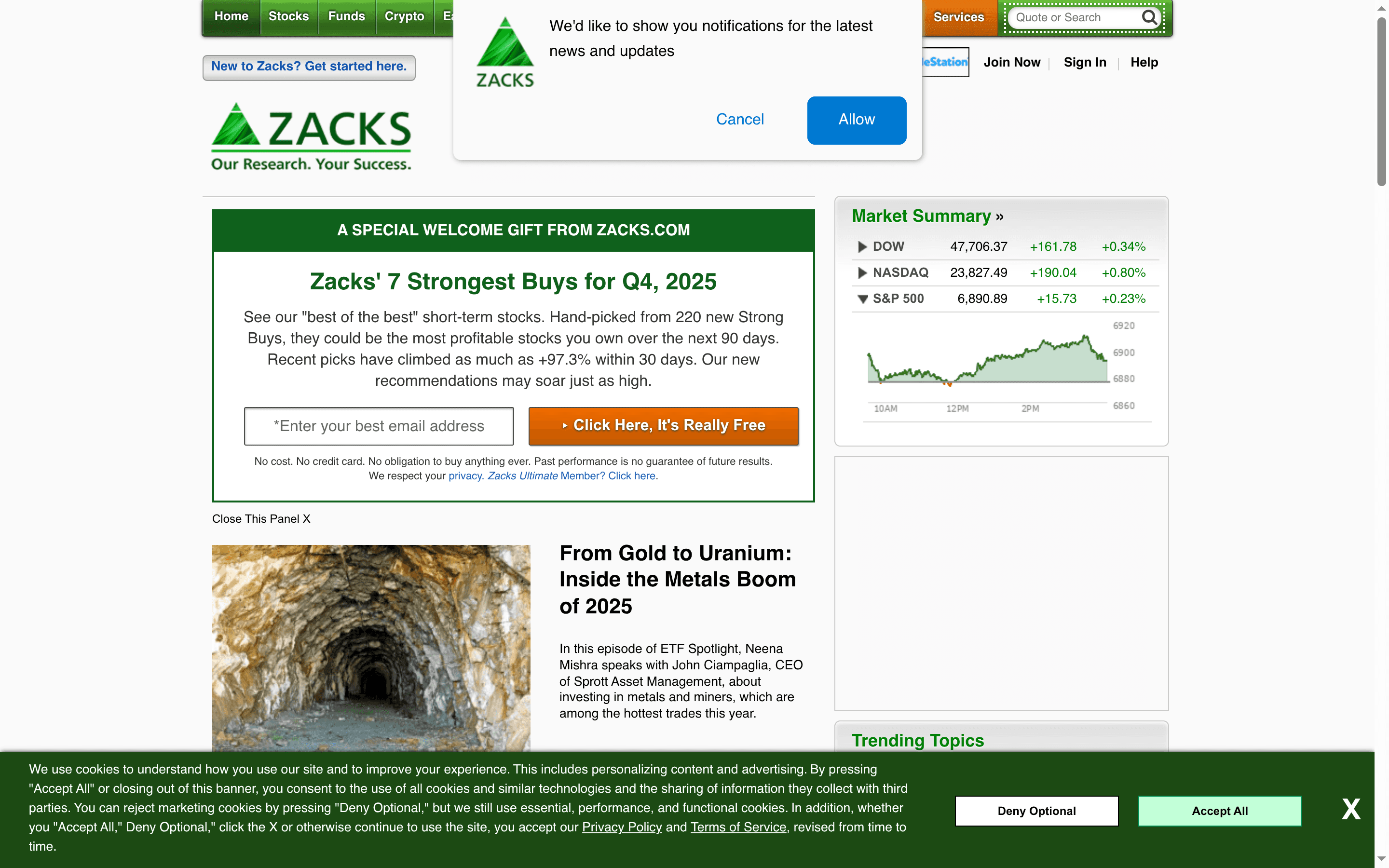

At a Glance
Zacks is a long-established financial research site focused on stock research, ranking, and market commentary designed to help investors make informed buy and sell decisions. It combines a structured stock-ranking system with regular market news and portfolio tools, offering material useful to both individual investors and professionals. That said, deeper reports and premium tools sit behind subscription paywalls, so expect a hybrid free/paid experience.
Core Features
Zacks centers on five core capabilities: stock research and analysis, market news and insights, a proprietary stock ranking system, investment recommendations, and basic portfolio management tools. The research and ranking system helps you prioritize ideas quickly, while news feeds and commentary keep you updated on market-moving developments. Portfolio features let you track positions and compare them against the firm’s rankings and recommendations in one place.
Short. Practical. Focused.
Pros
- Provides comprehensive stock analysis: Zacks aggregates quantitative and qualitative signals into research reports that help you evaluate individual securities.
- Offers investment tools and resources: The site includes ranking screens and portfolio tracking that make it easier to organize ideas and watch lists.
- Updated regularly with market news and insights: Daily news and commentary keep you informed about events that could affect holdings and strategy.
- Suitable for both individual investors and professionals: Content and tools are structured so both DIY investors and advisors can use them without major customization.
- User-friendly interface: The site is designed to make research and rankings accessible rather than buried behind complex navigation.
Cons
- Some features require a subscription: Many of the deeper reports and premium services are gated behind paid plans, limiting access for casual users.
- Complex for complete beginners: New investors may find the ranking methodology and research terminology steep without additional guidance.
- Limited free content compared to paid options: While basic tools are available at no cost, the most actionable recommendations and detailed reports are often reserved for subscribers.
Who It’s For
Zacks is best for self-directed investors who want a data-driven framework for stock selection, financial advisors looking for a research backbone, and market analysts who need regular ranking-based signals. If you prefer quantitative ranking systems and frequent commentary to guide trading or portfolio reviews, Zacks fits neatly into that workflow.
Unique Value Proposition
Zacks’ unique value lies in its systematic stock ranking system coupled with frequent market commentary, which together help users prioritize trade and investment ideas quickly. The combination of rankings and news reduces the time you spend sifting through tickers and focuses attention on names that meet Zacks’ quantitative criteria.
Real World Use Case
An investor preparing a quarterly portfolio rebalance uses Zacks to screen for stocks that fit their risk profile, reviews the site’s rankings and analyst notes for conviction, and monitors the news feed for any events that would change the decision. The result: a more disciplined rebalance driven by ranked ideas and current market context.
Pricing
Free tier available; premium services and detailed reports require a subscription—see the website for specific plan options and pricing.
Website: https://zacks.com
Stansberry Research


At a Glance
Stansberry Research delivers daily investment-focused email newsletters and a suite of more than 30 specialized research services aimed at helping individual investors protect and grow wealth. Backed by a community of over a million subscribers and analysts with hedge fund and industry experience, it blends educational material with actionable stock and market insights. If you want expert-driven ideas on technology, precious metals, and market trends delivered regularly, Stansberry is a heavyweight to consider — just be prepared for a marketing-forward presentation and an unclear price tag.
Core Features
Stansberry’s core capabilities center on daily email research newsletters, monthly featured reports, model portfolios, and a deep focus on disruptive and innovative sectors such as technology and biotech. The platform offers market analysis, specific stock recommendations, trend insights, and more than 30 distinct research services tailored to different investor experience levels. Content ranges from beginner-friendly educational pieces to expert analysis from former hedge fund managers and seasoned analysts.
Pros
- Experienced analyst roster: Stansberry leverages seasoned financial analysts and former hedge fund managers, which can provide nuanced market perspectives and credibility to their recommendations.
- Broad research lineup: With over 30 research services, the platform addresses multiple investor profiles, from novices seeking education to professionals seeking deeper research.
- Sector specialization: A clear emphasis on innovative and disruptive sectors like technology and biotech makes it useful for investors who want targeted exposure to growth themes.
- Regular, actionable communications: Daily emails and monthly model portfolios keep subscribers engaged and provide frequent, actionable ideas rather than occasional commentary.
- Educational orientation: The mix of educational content alongside recommendations helps newer investors build knowledge while following concrete ideas.
Cons
- Subscription costs implied but unclear: Premium services appear to require a subscription fee, yet the exact pricing structure is not presented in the provided site content.
- Marketing-forward presentation: The content is described as heavily marketing-oriented with frequent promotions, which can make it harder to separate unbiased research from sales messaging.
- Opaque pricing details: Because pricing is not explicitly stated in the available materials, potential subscribers must perform extra legwork to understand total costs.
Who It’s For
Stansberry Research is best suited for individual investors across experience levels who want frequent, analyst-driven investment ideas and educational resources. It appeals to retirees seeking wealth protection strategies, new investors looking to learn market fundamentals, and financial professionals who want curated research on emerging trends and specific sectors.
Unique Value Proposition
Stansberry combines a high-frequency delivery model (daily emails) with specialized, sector-focused research and a large subscriber community. That mix gives readers continual market ideas supported by analysts with professional investing backgrounds — a blend of education plus recommendations that aims to accelerate learning while offering actionable opportunities.
Real World Use Case
A retired couple on a fixed income could use Stansberry’s newsletters and model portfolios to identify lower-risk income ideas and select targeted growth opportunities in areas like precious metals or technology, while relying on educational pieces to gauge and manage portfolio risk.
Pricing
Not explicitly stated on the website content provided.
Website: https://stansberryresearch.com
InvestorPlace


At a Glance
InvestorPlace is a market-focused newsletter and research platform that delivers stock market news, trading tips, and sector-focused analysis—especially on stocks, AI, and macro trends. It packages expert opinions, rankings, and special reports into email newsletters and web content aimed at helping investors cut through daily noise. Bottom line: if you want timely commentary and a wide variety of newsletters to tailor to different strategies, InvestorPlace is a practical, low-friction resource.
Core Features
InvestorPlace centers on timely stock market news and analysis, offering stock advice, trading tips, and newsletters delivered directly to your email inbox. The platform publishes market reports and special analyses that synthesize macroeconomic context with sector-level implications, and it features expert opinions and rankings to highlight stock ideas and industry movers. Content spans multiple newsletters and social channels, creating several touchpoints for you to consume research in short-form updates or deeper special reports.
Pros
- Comprehensive market analysis and insights: InvestorPlace compiles news, macro context, and sector commentary into readable analyses that help you see the bigger picture behind market moves.
- Variety of newsletters for different investment strategies: You can pick newsletters that align with short-term trading, long-term investing, or thematic interests like AI, giving you options rather than a one-size-fits-all feed.
- Expert opinions and research reports: The platform provides ranked ideas and specialist takes that make it easier to compare competing viewpoints on a single stock or sector.
- Active social media presence and updates: Frequent updates across channels help you catch time-sensitive market developments as they unfold.
- Resources suitable for both beginner and advanced investors: From high-level market summaries to deeper reports, the content range supports newcomers and experienced traders alike.
Cons
- Content may be more opinion-based and less actionable for specific trades: Much of the material focuses on analysis and viewpoint rather than step-by-step trade execution plans.
- Focus on stock market news may not cover all investment types: If you want fixed income, commodities, or alternatives coverage, you may find the scope limited.
- Potential information overload for casual investors: The volume and variety of newsletters and updates can be overwhelming unless you curate which feeds you follow.
Who It’s For
InvestorPlace is aimed at retail investors, traders, and financial enthusiasts who prioritize equity research and market commentary. If you value expert ranking, thematic coverage (like AI), and a mix of quick alerts plus deeper reports, this platform will serve you well. It’s less suited to investors seeking niche asset-class research outside of equities.
Unique Value Proposition
InvestorPlace’s strength is its breadth of stock-focused newsletters and its blend of macro and thematic analysis, which helps you link big-picture trends to concrete stock ideas. The combination of ranked opinions, special reports, and frequent updates creates a reliable pipeline of ideas without a heavy paywall barrier—most subscriptions are free.
Real World Use Case
An individual investor subscribes to InvestorPlace newsletters to receive daily market summaries and monthly special reports on AI. They use the ranked ideas and expert commentary to build a watchlist, then cross-check trade timing with other signals before executing.
Pricing
Most newsletter subscriptions are free.
Website: https://investorplace.com
Financial News and Research Platforms Comparison
This table compares several financial news and research platforms based on their core offerings, strengths, weaknesses, pricing, and best-suited audience. It provides a clear overview for investors seeking the right platform for their financial information needs.
| Platform | Core Features | Pros | Cons | Pricing |
|---|---|---|---|---|
| Finblog | Trending market news, expert commentary, form-focused UX | Comprehensive coverage, timely updates, user-focused design | Primarily lead-capture focused | Not specified, likely free access |
| The Motley Fool | Monthly stock picks, portfolio strategies | Proven track record, tailored strategies, educational tools | Subscription costs, stock-focused | Starts at ~$199 annually |
| Investors Alley | Market analysis, dividend research, energy commentary | Comprehensive education, timely analysis, credibility | Educational, not personalized, few tools | Not specified |
| Seeking Alpha | In-depth analysis, real-time news, contributor articles | Wide asset coverage, community insights, timely updates | Account required for some content, potential bias | Free tier available |
| Zacks | Stock research, market news, proprietary ranking, portfolio | Comprehensive analysis, investment tools, frequent updates | Subscription needed for premium features, complexity concern | Free tier available |
| Stansberry Research | Daily newsletters, model portfolios, sector focus | Experienced analysts, broad research, sector specialization | Marketing-heavy, unclear pricing | Not explicitly stated |
| InvestorPlace | Stock market news, trading tips, sector-focused newsletters | Comprehensive analysis, variety of newsletters, expert opinions | Possible information overload, stock-focus | Most newsletters are free |
Make Smarter Investment Choices with Finblog Today
Navigating the world of investment newsletters for 2025 can feel overwhelming. You want clear comparisons that highlight what truly matters: reliability, actionable advice, and expert insights tailored to your financial goals. This article uncovers the challenge many face—finding a newsletter that not only delivers timely market updates but also helps turn information into confident decisions without the clutter or confusion.
At Finblog, we understand your need for clarity and trust. Our platform pairs comprehensive financial news with a user-focused experience that prioritizes your journey from learning to earning. With custom forms designed for seamless signups and secure access, you can quickly connect to tailored advice and expert guidance. Don’t miss out on converting your curiosity into real investment strategy today. Visit Finblog and explore how we make financial education simple, secure, and actionable. Take control now by starting with our landing page and step confidently into your best investing year yet.
Frequently Asked Questions
What are the key factors to consider when comparing investment newsletters for 2025?
When comparing investment newsletters for 2025, consider factors such as the quality of the analysis, the types of investments covered, delivery frequency, and any educational resources provided. Start by assessing the specific investment strategies each newsletter offers to ensure they align with your financial goals.
How can I determine which investment newsletter offers the best educational content?
To determine which investment newsletter offers the best educational content, review samples of their articles or educational resources. Look for newsletters that provide comprehensive guides or tutorials alongside their recommendations to enhance your understanding of investment concepts.
What type of investment strategies do different newsletters focus on?
Various investment newsletters focus on different strategies, including long-term investing, day trading, or specialized sectors like technology or dividend stocks. Identify your preferred investment approach and seek newsletters that emphasize relevant strategies to suit your trading style.
How often should I expect to receive updates from investment newsletters?
Most investment newsletters typically provide updates on a daily, weekly, or monthly basis, depending on the type of service. Consider your own investment needs, and choose a newsletter that aligns with how often you want to receive insights or market updates.
Is it possible to get a free trial for investment newsletters in 2025?
Many investment newsletters offer free trials or introductory periods to allow new subscribers to evaluate their content. Look for newsletters that provide this option, so you can test their features and recommendations before committing to a subscription.
What metrics can I use to evaluate the performance of an investment newsletter?
You can evaluate the performance of an investment newsletter by tracking its historical returns, subscriber success stories, and the accuracy of its recommendations. Maintain a record of the newsletter’s suggested trades over a defined period, such as six months, to assess its effectiveness against your investment performance.










